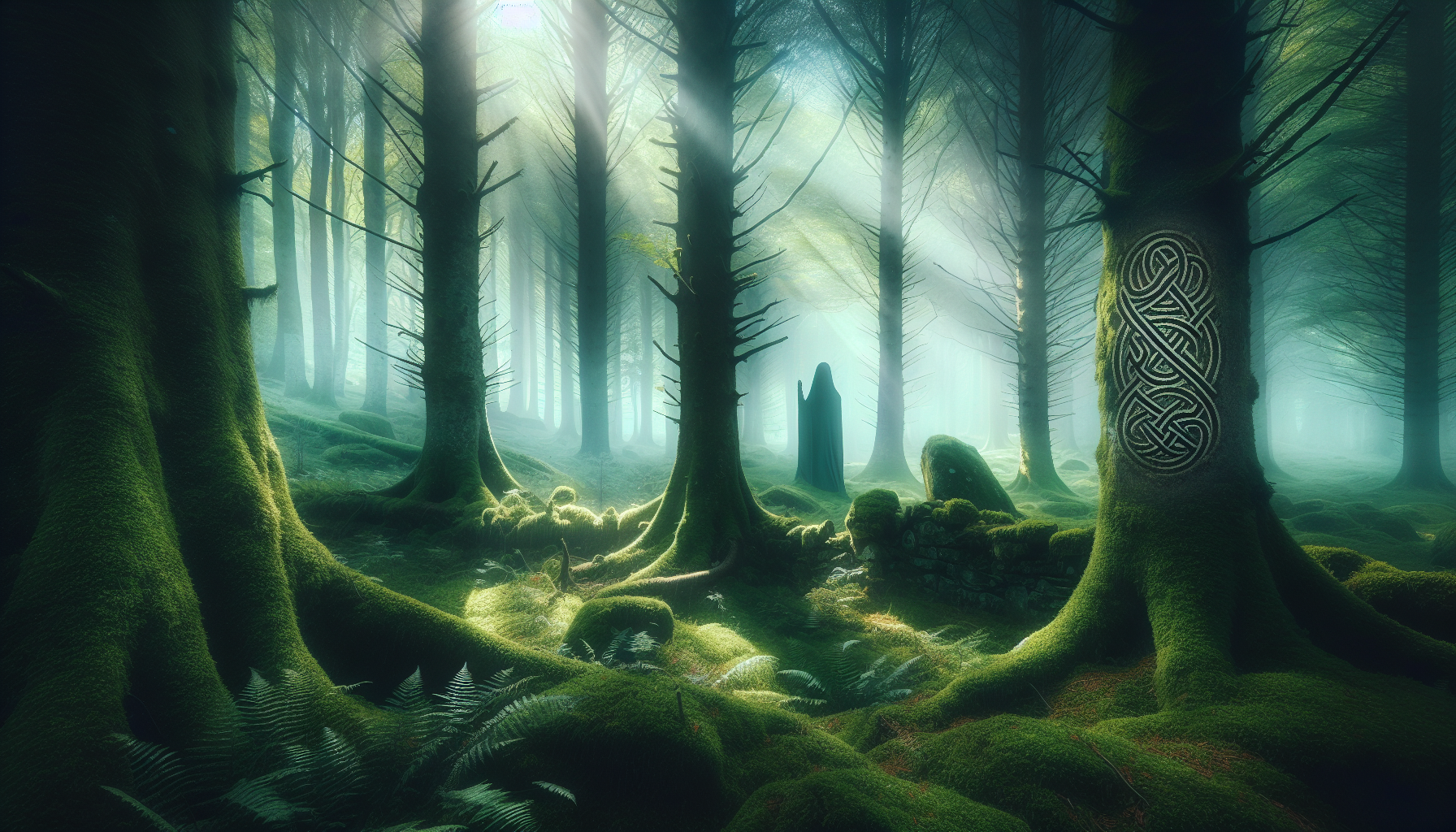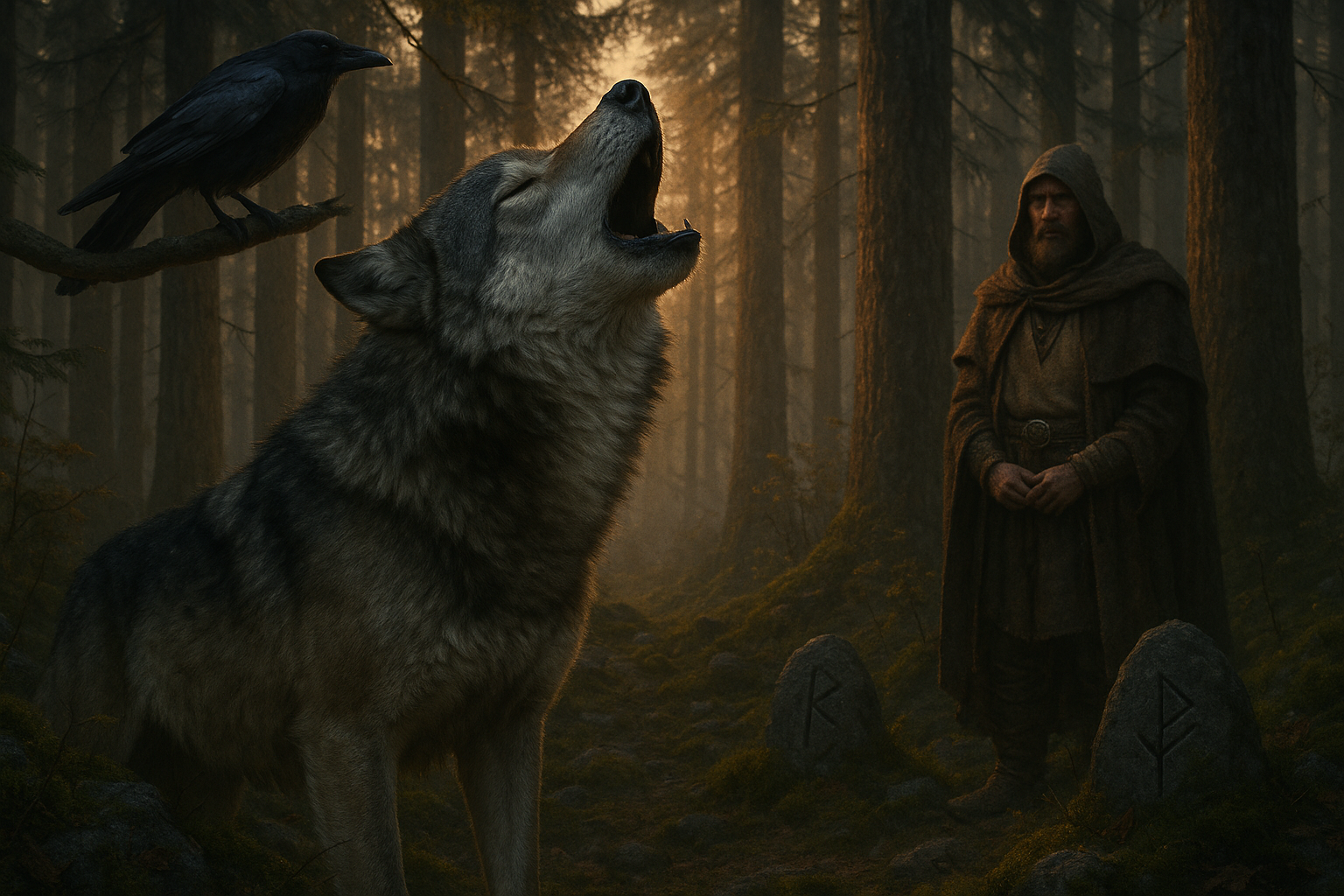In the heart of Europe, where mist-laden hills rise to kiss the cloudy sky and rivers wind like ancient serpents through verdant valleys, lies a world steeped in mystery and magic. This is the realm of the Celtic woods, an enchanted landscape where time seems to flow in a loop, echoing the whispers of a bygone era. These forests are more than just a tapestry of flora and fauna; they are the living embodiment of tales spun from the threads of history, mythology, and legend. As the wind rustles through the leaves, it carries with it stories untold, secrets of the past, and a haunting melody that beckons the curious and the brave to uncover its mysteries.
In this article, we embark on a journey through the Celtic woods, exploring their haunted echoes and the legends that have persisted through the ages. Imagine stepping into a forest where the very air seems charged with magic, where every shadow could conceal an ancient spirit, and where the rustling of leaves might just be the whisper of a long-forgotten ghost. These woods, with their gnarled trees and moss-covered stones, are not merely the backdrop of supernatural tales; they are active participants in the folklore that has shaped the cultural fabric of Celtic societies.
As we delve deeper, we’ll uncover the fascinating interplay between the natural world and the supernatural, exploring how the Celts perceived their forests as sacred spaces teeming with spiritual significance. From the Druids, the mysterious priestly class who were said to commune with the spirits of the woods, to the fairy folk and mythical creatures believed to inhabit these sylvan realms, the Celtic woods are a rich tapestry of mythology and belief. Each tree is a witness to centuries of ritual and reverence, each clearing a stage for age-old ceremonies and rites.
We’ll also explore the enduring influence of these haunted woods on literature and popular culture. From the hauntingly beautiful poetry of W.B. Yeats to the contemporary tales of Neil Gaiman and J.K. Rowling, the Celtic forests have inspired countless authors and artists. These stories, though fictional, draw deeply from the wellspring of Celtic myth, breathing new life into the ancient tales and ensuring their place in the modern imagination. Through these narratives, the haunted echoes of the Celtic woods find new voices, resonating with audiences across generations.
Join us as we navigate the winding paths of these ancient forests, each step drawing us closer to the heart of their haunting allure. Whether you’re a seasoned believer in the supernatural or a curious skeptic, the whispers of the Celtic woods promise to enchant, thrill, and perhaps even haunt your thoughts long after you’ve turned the final page. So, take a deep breath, open your mind to the possibilities, and let’s venture into the shadows of history, where the past and present dance in an eternal waltz under the canopy of ancient trees. 🌲✨
The Mystique of Celtic Forests: A Historical Overview
The dense and enchanting forests of the Celtic regions have long captivated imaginations with their mysterious allure and historical depth. These ancient woods, shrouded in mist and legend, are often seen as gateways to a world where the past meets the present in whispers carried by the wind. For centuries, the Celts revered these forests not only as natural resources but as sacred spaces teeming with spirits and stories. The rich tapestry of Celtic folklore is woven with tales of mythical creatures, ancient druids, and haunted echoes that still resonate today.
The Celts, known for their profound connection to nature, saw these forests as living entities imbued with spiritual significance. Each tree and stone was thought to be alive with the spirits of ancestors or gods. This deep reverence is evident in Celtic mythology, where forests frequently serve as the setting for tales of heroism and mysticism. From the legendary tales of King Arthur, where the forest serves as a backdrop for the quest for the Holy Grail, to the haunting tales of the Cailleach, the forest witch, the woods have always been central to the Celtic imagination.
In these forests, the druids, the learned class of the Celts, practiced their rituals and ceremonies. These spiritual leaders believed in the power of the natural world and sought to understand the mysteries of life through the forest’s silent whispers. The druids considered certain trees sacred, each possessing unique attributes and associations with different deities. For example, the oak was revered for its strength and endurance, the yew for its connection to death and rebirth, and the rowan for its protective powers.
As you delve into the echoes of these ancient forests, it’s essential to appreciate their historical context. Celtic tribes inhabited vast regions of Europe, from the British Isles to mainland Europe, each with its unique forest landscapes. While much of their history has been lost to time, the remnants of their culture continue to thrive in these woodlands, offering a glimpse into a world where the boundary between the natural and supernatural is tantalizingly thin.
Haunted Echoes: Stories and Legends of the Celtic Woods
The forests of the Celtic lands are rife with legends and stories that speak of haunted echoes lingering in the trees. These tales, passed down through generations, form an integral part of Celtic folklore, revealing a deep-seated belief in the supernatural. One of the most enduring legends is that of the Wild Hunt, a ghostly procession of phantom riders who sweep through the night sky, heralding doom and misfortune. Said to be led by a spectral huntsman or even deities like Odin, the Wild Hunt is a chilling reminder of the forest’s otherworldly nature.
Another intriguing story is that of the Banshee, a female spirit whose mournful wails foretell death. Often associated with families of ancient Celtic lineage, the Banshee is said to wander the forests, her cries echoing through the trees as a warning of impending tragedy. This belief in the Banshee underscores the Celts’ connection to their ancestors and the idea that the forest serves as a bridge between the living and the dead.
Yet, not all tales of the Celtic woods are ominous. The Selkies, mythical creatures capable of transforming from seals to humans, are often depicted as benign, if mischievous, beings. They are said to shed their seal skins to dance on moonlit shores before slipping back into the sea. These enchanting creatures highlight the Celts’ belief in the interconnectedness of land and sea, nature and magic.
The legends of the Tuatha Dé Danann, a race of supernatural beings, further illustrate the mystical nature of the Celtic woods. These god-like figures, possessing great beauty and power, were said to inhabit the forests, emerging at times to interact with humans. Their stories are woven into the fabric of Celtic mythology, serving as reminders of the forest’s role as a realm of enchantment and mystery.
The Spiritual Significance of Celtic Trees
In the Celtic tradition, trees are revered as symbols of life, wisdom, and strength. Each species holds a unique place in Celtic spirituality, representing various aspects of existence. The Celtic tree calendar, an ancient system based on the lunar cycle, assigns different trees to specific times of the year, reflecting their significance in the natural and spiritual world.
The oak, known as the king of the forest, is a symbol of strength and resilience. Its deep roots and towering stature made it a revered tree among the Celts, often associated with thunder gods like Taranis. The oak’s acorns were seen as symbols of potential and growth, while its wood was used in sacred fires and rituals, believed to purify and protect.
The yew tree, with its long lifespan and ability to regenerate, is associated with death and rebirth. Often found in ancient burial sites, the yew symbolizes the cyclical nature of life, a concept central to Celtic spirituality. Its connection to the afterlife and the divine is reflected in its presence in many sacred groves and sites of worship.
The rowan tree, known for its bright red berries, is considered a protective symbol against evil spirits. The Celts believed that the rowan possessed magical properties that could ward off malevolent forces, and it was often planted near homes and places of worship as a protective measure. Its association with magic and protection highlights the Celts’ belief in the power of nature to influence and safeguard their lives.
The birch tree, representing new beginnings and purification, is associated with the start of the Celtic tree calendar. Its white bark and ability to thrive in challenging conditions make it a symbol of renewal and resilience. The Celts saw the birch as a harbinger of hope and transformation, marking the transition from the dark winter months to the light of spring.
Comparative Table: Celtic Trees and Their Symbolism
| Tree | Symbolism | Associated Deity |
|---|---|---|
| Oak | Strength, Endurance | Taranis |
| Yew | Death, Rebirth | None specific |
| Rowan | Protection, Magic | Brigid |
| Birch | New Beginnings, Purification | None specific |
Modern Interpretations and Cultural Influence
The whispers of the Celtic woods continue to echo in modern times, influencing contemporary culture in myriad ways. The enduring appeal of Celtic mythology is evident in literature, film, and art, where themes of nature, magic, and mystery are explored through new lenses. This cultural fascination underscores the timelessness of these ancient tales and their ability to resonate with modern audiences.
One of the most notable examples of Celtic influence in contemporary media is the use of forest settings in fantasy literature and films. Works like J.R.R. Tolkien’s “The Lord of the Rings” and the “Harry Potter” series draw heavily on Celtic motifs, using enchanted forests as key elements in their narratives. These stories often reflect the themes of heroism, adventure, and the supernatural found in Celtic legends, bringing the magic of the ancient woods to life for new generations.
Music, too, has been deeply influenced by Celtic themes. The haunting melodies of Celtic folk songs and modern interpretations by artists like Loreena McKennitt and Enya evoke the mysticism and beauty of the forests. These musical expressions serve as a bridge between the past and present, allowing listeners to experience the spiritual and emotional depth of Celtic heritage.
The influence of Celtic culture is also evident in modern spiritual practices. The resurgence of interest in pagan and earth-based religions has led many to explore Celtic spirituality, drawing on its reverence for nature and the interconnectedness of all things. Practices such as druidism and Wicca often incorporate elements of Celtic mythology and symbolism, emphasizing the sacredness of the natural world.
For those interested in exploring these themes further, there are numerous resources available. From documentaries exploring Celtic history to online courses on druidic practices, the wealth of information allows enthusiasts to dive deep into the rich tapestry of Celtic culture. To start your journey, consider watching this insightful video: “Exploring the Mysteries of Celtic Forests” – Channel Name. 📹

Conclusion
Concluding our exploration of the mesmerizing yet haunting realm of Celtic forests, we find ourselves deeply immersed in a narrative that intertwines history, mythology, and the supernatural. Throughout this article, we’ve delved into the whispers of the Celtic woods, uncovering tales that have been passed down through generations, each echoing with the voices of ancient spirits and the mysterious forces that inhabit these enchanted landscapes.
The Celtic woods are not just forests; they are living entities, bearing witness to the passage of time and the myriad of stories that have unfolded beneath their canopies. We began by exploring the historical significance of these forests, recognizing them as sacred spaces for the Celtic people. These woodlands were not only vital for their resources but were also revered as spiritual sanctuaries. The Celts believed that their gods and ancestors resided within the trees, rocks, and streams, creating a tapestry of myth and reality that continues to captivate our imagination today.
As we journeyed further, we encountered the legends that have emerged from these mystical environments. From tales of the Sidhe, or fairy folk, who are said to dwell within the shadows of the trees, to the haunting banshees whose cries foretell doom, the Celtic forests are teeming with supernatural lore. These stories are more than mere folklore; they reflect the values, fears, and hopes of the Celtic people, offering us insights into their worldviews and spiritual beliefs.
Moreover, we examined the cultural impact of these haunted echoes, noting how they have influenced literature, art, and even modern pop culture. The allure of the Celtic forests has inspired countless artists and writers, from the romantic poets of the 19th century to contemporary filmmakers, all drawn to the mysterious and otherworldly essence of these ancient woods. This enduring fascination speaks to the universal human experience of awe and reverence for nature, as well as our innate curiosity about the unknown.
In understanding the ecological importance of these forests, we are reminded of the delicate balance between preservation and myth. The Celtic woods are home to a rich diversity of flora and fauna, and their conservation is crucial not only for maintaining biodiversity but also for preserving the cultural heritage they embody. By protecting these natural spaces, we ensure that the whispers of the Celtic woods continue to inspire and enchant future generations.
The stories and spirits of the Celtic forests invite us to reflect on our own connection to the natural world. In an era where technology often distances us from nature, these ancient woods offer a reminder of the profound interconnectedness of all living things. They challenge us to listen more closely to the whispers of the earth and to honor the wisdom that resides within it.
As we conclude, it’s important to recognize the significance of engaging with these stories, not just as relics of the past, but as living narratives that can enrich our lives. By sharing these tales, we keep the spirit of the Celtic woods alive, allowing their echoes to resonate with new audiences. We encourage you, dear reader, to delve deeper into the lore of these mystical forests, to explore their stories, and perhaps, to visit these enchanting places yourself.
Feel free to comment below with your thoughts and reflections. Have you experienced the magic of a Celtic forest? What stories have you heard or read that have touched your heart? Sharing these experiences helps to keep the tradition alive and fosters a community of storytellers who cherish and preserve this rich cultural heritage.
Additionally, consider sharing this article with friends and family who might be intrigued by the haunting beauty of the Celtic woods. Together, we can create a tapestry of shared knowledge and appreciation for these ancient echoes that continue to captivate our imaginations.
To learn more about Celtic mythology and the preservation of these forests, you might find these resources insightful:
– Forest Conservation Efforts 🍃
As we part ways with the spirits and stories of the Celtic woods, let’s carry their whispers with us, allowing them to inspire and guide us in our own journeys. May the echoes of these ancient forests continue to haunt and inspire, reminding us of the beauty and mystery that lies within the natural world. 🌿✨
- Explore the rich history of Celtic forests and their cultural significance.
- Discover the legends and myths that echo through these ancient woods.
- Understand the spiritual symbolism of Celtic trees and their role in mythology.
- Learn about modern interpretations and cultural influences of Celtic themes.
- Support conservation efforts to preserve the ecological and cultural heritage of Celtic forests.
Toni Santos is a sound storyteller and folklore researcher whose creative path bridges the mystical and the biological through the lens of bioacoustic folklore. With an ear attuned to the voices of nature, Toni explores how ancient cultures interpreted birdsong, forest echoes, and animal calls—not as noise, but as messages, omens, and myths encoded in sound.
Rooted in a passion for both natural science and ancestral lore, his work uncovers the forgotten connections between ecosystems and oral traditions. From the whispered warnings in owl cries to the songs of frogs heralding rain, Toni’s narratives evoke a time when humans listened to nature with reverence and meaning.
Drawing on a background in ecological arts and auditory storytelling, Toni merges field recordings with mythic imagery, turning natural sounds into cultural artifacts of wonder. His stories do more than entertain—they restore a way of hearing the world that blends intuition, memory, and deep listening.
As the creative force behind Vizovex, Toni offers sonic tales, symbolic soundscapes, and research-based reflections that help others rediscover the sacred language of the wild.
His work is a tribute to:
The mythological significance of animal and elemental sounds
Ancient practices of listening for meaning in nature
The spiritual dialogue between humans and soundscapes
Whether you’re a folklorist, an acoustic ecologist, or a curious listener, Toni invites you into a world where the forest speaks, and every chirp, croak, and howl carries a story—one echo, one legend, one call at a time.



